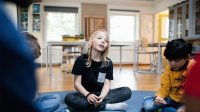What Students Will Need as the Year Begins
After a year of chronic unpredictability, both students and teachers will benefit from focusing on relationships and the daily rhythms of school.
As we reflect on our current educational landscape and the social and emotional implications of the pandemic over the past 18 months, we see that, unfortunately, many school districts and policy makers around the country are addressing “learning loss” as one of our greatest challenges in the 2021–22 academic year.
There’s no doubt that learning has been lost, but at the root of this loss is the fragile emotional and mental health of our children and youth. Our educators have also experienced tremendous anxiety, feeling overwhelmed with the chronic unpredictability over this past year.
What does this mean for the upcoming school year? Here are a few things we will need to prioritize in our classrooms as the school year begins.
Connection Begins With the Adults in the Building
When educators intentionally care for one another, our students benefit from the atmosphere of safety. We come into this world wired for connection—it’s a biological imperative. Our nervous systems require reciprocity to regulate our states so that we feel safe. A sense of belonging brings satisfaction, and our individual sense of happiness is impacted by being part of a social network. We lost this connectedness last year, and the residual effects of felt isolation and chronic unpredictability will be remembered for years to come. Cultivating a familial culture in our classrooms and schools will help to mitigate those feelings of isolation, loss, and loneliness.
Schools will need to be intentional about creating routines and schedules throughout the school day that are not only predictable but cultivate the emotional and physical stamina that many of our students will need, especially those who were in remote learning for all or most of last year.
Prioritizing frequent or check-ins with our students will be calming as these moments of connection can strengthen a sense of autonomy while validating what is going right and well. Adolescents will need these check-ins as much as, if not more than, younger students because they are moving through a heightened simultaneous pruning and proliferation of synaptic connections during the adolescent years and through young adulthood. A check-in can be a hand on the shoulder, gentle eye contact, a Post-it note or other greeting, or a personalized signal or routine with a student.
Daily Rhythms
Morning meetings will be helpful for students of all ages—all the way up through high school. These gatherings prepare the nervous system for learning and allow everyone to check in with one another. Passing a small drum is a novel and engaging choice—as students pass the drum, each one can choose to share their own rhythmic beat that aligns with how they are feeling in that moment. They can drum to the rhythm, speed, and volume of their nervous system each morning, during transitions, or the end of the day. Then teachers can lead a discussion of the patterns they noticed. Was the rhythm soft and slow? Was it fast and loud? Was it chaotic, or did it have a smooth, coherent beat? When students are feeling rough and dysregulated, what types of rhythms feel relaxing or comforting to them?
Our students have not been required to sit for seven hours a day working on academic assignments for quite some time. Teachers can help them get back into the rhythm of school by chunking assignments with recurrent movement, water, and snack breaks. Teachers may need to focus on shorter periods of work, focusing on quality and not quantity. If students understand content and can apply it as required, teachers can gradually increase the length and duration of assignments to keep students engaged and focused on learning.
Movement will also be important as students will need exercise and breaks to help reduce tension and stress that are felt but not often addressed. Focused attention practices will be an important part of class routines—integrating intentional breathing, rhythmic practices, and sensory accommodations that aid in creating a sense of calm and safety in the body that can anchor our nervous systems for improved attention, working memory, and successful learning.
The rhythms of life are always about ruptures and repairs, and during the past year, our schools experienced a significant amount of rupture without the time, space, and opportunities to repair. We will need to acknowledge the adversity and trauma students have experienced and find new ways of repairing, leading, teaching, and living life with the emotional, mental, and physiological well-being that is the birthright of every human being.
